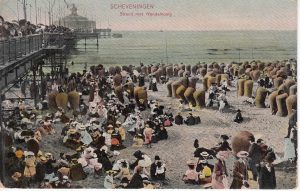Sometimes a topic for an article comes from an unexpected source. My sister had been sorting my grandmother’s postcard collection and of course she gave me the cards with images from The Hague. A number of those postcards show pictures of the Wilhelmina Promenade Pier at Scheveningen, which sadly no longer exists.
The opening
In the Algemeen Handelsblad of that day we read that “with the construction of that work after the original drawing of the Brussels engineer Wijhowski, who also made the plan for the pier at Blankenberghe, to the varied entertainment that the Kuroord offers, is now added a place for relaxation, which enables Scheveningen to compete with the most important seaside resorts in Europe”.
Before the opening
However, in newspaper reports during more than 30 years prior to the opening, it can also be read that there was a lot of opposition to the construction of the promenade pier. Fishermen who sailed from Scheveningen were convinced that the pier would be an obstacle for their vessels, which at that time still had to be hauled onto the beach. Only the promise of a harbour, which was eventually built in 1904, made the fishermen to give up their protest.
The permit for the promenade pier stipulated that in the event of war or danger of war, the Minister of War could, without prior warning and without compensation, demolish the structure. Special officers were therefore given free access to the pier as necessary to prepare for possible destruction.
Working on the coast, the contractors were naturally affected by the weather. More than a year before the opening, a storm caused considerable damage.
Wilhelmina Promenade Pier
The pavilion, and also the terrace and shopping gallery that connected the pier at the landward end with the Kurhaus, were designed by architect W.B. van Liefland of The Hague.
Within six months after the opening, around 800,000 people had visited the pier. The fee was 10 cents.
The end
Over the years, silting made the water near the shore too shallow for boats to reach the jetty. So in 1913, this part of the pier was removed.
In the spring of 1942, as the occupying Germans were building sections of the Atlantic Wall in The Hague, Scheveningen — and the Wilhelmina Pier – became ‘Sperrgebiet’ (restricted). The Germans used the pavilion as a storage facility and placed anti-aircraft guns on the pier. To prevent any Allied forces from using the pier for invasion, they removed 30 meters of planks. A fire destroyed the pavilion on March 26, 1943. After the fire, the Germans demolished the entire pier by cutting off the timber posts supporting the structure. Remnants of the pier remained visible until 1958, when they were cleared in anticipation of the construction of the very different pleasure pier you see today.
But all this was totally unknown to Miss E. Spannet, living on Weesperstraat in Amsterdam, when she received a postcard from the Roos family in 1910. Just like she did not know then that she would have a granddaughter who would become a tour guide to The Hague.
I will tell you more about the history of Scheveningen during the bicycle tour ‘From City to Sea’.










